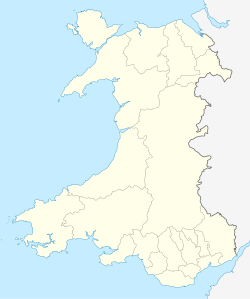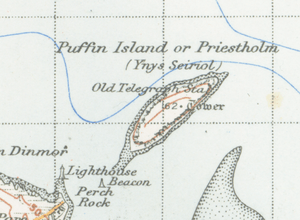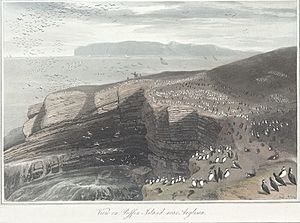Puffin Island (Anglesey) facts for kids
|
Native name:
Ynys Seiriol
|
|
|---|---|

Puffin Island seen from Penmon Point
|
|
| Geography | |
| Location | Anglesey, Wales |
| Coordinates | 53°19′00″N 4°01′00″W / 53.31667°N 4.01667°W |
| Administration | |
|
Wales
|
|
| County | Anglesey |
| Demographics | |
| Population | 0 (uninhabited) |
Puffin Island, known in Welsh as Welsh: Ynys Seiriol, is a small island near Anglesey, Wales. No one lives on the island today. It used to be called Priestholm in English and Ynys Lannog in Welsh. Long ago, around the 500s, a special religious retreat was built here. You can still see parts of a monastery from the 1100s. Puffin Island is also a very important place for birds and other wildlife. It is a Special Protection Area to keep them safe.
Island Geography
Puffin Island is the ninth largest island off the coast of Wales. It marks the northeastern end of the Menai Strait. The island's highest point is made of Carboniferous Limestone. It stands about 192 feet (58.5 meters) above the sea. The island has steep cliffs all around. Puffin Island covers an area of about 69 acres (0.28 square kilometers). A private estate called Baron Hill owns the island.
Island History
The Welsh name, Ynys Seiriol, means "Seiriol's Island." Saint Seiriol was a very important person in the 5th century. He was the son of a ruler of the Kingdom of Gwynedd. Seiriol started a religious settlement called a clas at Penmon on Anglesey. Later in his life, he moved to the nearby island. He wanted to live a quiet life in a hermitage. People believe his remains are buried there.
Around the year 630, King Cadwallon ap Cadfan of Gwynedd hid on the island. He was running away from an invasion by the Kingdom of Northumbria. A monastery was built on the island in the late 1100s. A writer named Gerald of Wales visited in 1188. He wrote that if the monks argued, mice would eat all their food!
Later, in 1221 and 1237, Llywelyn the Great made rules to protect the monastery. These rules said that the Canons Regular owned the island. They also owned the church and manor of Penmon on the mainland.
You can still see the ruins of old buildings on the island. These include parts of a church from the 1100s. This church is a Grade I heritage site. The middle tower and the base of the nave (the main part of the church) are still there. A cottage built in the 1800s covers other parts of the old church.
Much later, a telegraph station was built on the island. It was used to send messages. This station is not used anymore.
There is one known shipwreck near the island. It was a steamship called The Pioneer. In 1878, it ran aground (hit the shore) after its tow lines broke. This happened near the Skerries. The ship was carrying iron bars.
Amazing Wildlife

Puffin Island is a Special Protection Area (SPA). This means it's a very important place for wildlife. It has a huge colony of great cormorants. Over 750 of these birds live here! This is more than 10% of all the great cormorants in the British Isles.
Many other birds also nest on the island. These include guillemots, razorbills, shags, and kittiwakes. In recent years, a few common eiders and black guillemots have also started nesting.
The island gets its name from the Atlantic puffins. There used to be many puffins here, with up to 2,000 pairs! But then, brown rats accidentally came to the island. They caused the puffin numbers to drop a lot. In 1998, a program started to remove the rats. It seems to have worked! The puffin population has grown since then, with up to 300 birds now. Manx shearwaters and storm petrels are also thought to breed on the island.
Years ago, many rabbits lived on the island. They ate a lot of the plants. But then, a disease called myxomatosis wiped them out. This allowed many plants, especially common elder trees, to grow thickly.
The strong currents around the island create a rich home for sea life. This is especially true on the north coast, where the water is about 15 meters (49 feet) deep. Many people enjoy fishing trips from Beaumaris in these waters. They mostly catch mackerel, but many other fish species are also found.
All this fish attracts a large group of grey seals. Bottlenose dolphins and harbour porpoises also visit the area often. You can take boat trips from Easter to October to see the island, its seals, and its many birds.




